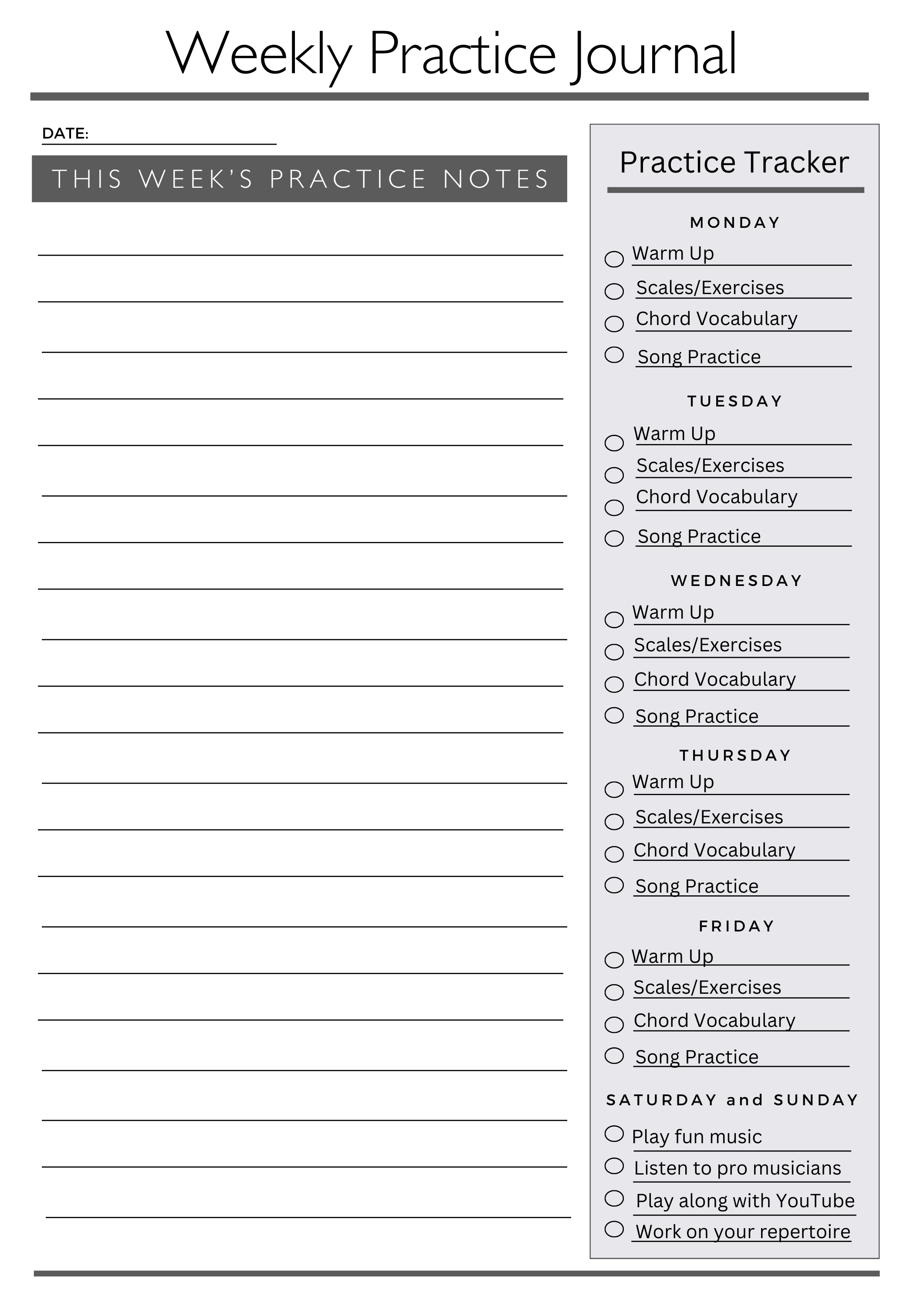Ukulele Practice Journal
What to Practice to Play Better

How does a Practice Journal help me to play better?
Knowing what to practice and how to practice is one of the most important elements for progress on an instrument. The other is your own passion to learn. The Ukulele Practice Journal outlines foundational skills in an easy-to-use format. As you follow through with weekly practice sessions, you’ll see and hear your playing improve. The scales will give you a better command of the fretboard, the chord families and progressions will help you with learning songs, the practice tips and warm-up exercises will add variety to your practice sessions, making them more enjoyable. Repetition is not the only way to practice and boredom is not a practice requirement!
You can use the Ukulele Practice Journal in conjunction with your regular music lessons or, if you are a DIY learner, you can use it with YouTube tutorials or lesson books. When you have a map that shows you what to practice, your ukulele journey becomes more exciting every day. And, by the end of a year, you will have at your fingertips 12 major and minor scales, 4 pentatonic scales, 12 chord families, 3 common chord progressions in 12 keys, 12 different ways to practice, a 5-step method for learning songs, some basic music theory, and access to resources and tools in the back of each journal.
If you choose to take more than a year to work through the journal, we offer additional blanks for the repertoire builder, monthly goals, and weekly checklist sheets (downloadable pdf format from our website).
Anyone can keep a journal, and this Ukulele Practice Journal will help you organize and track your progress over the course of a year.
This practice journal is full of useful content - not just blank pages and checklists!
The journal is laid out in a 12-month format that includes foundational material prompts. It continues with weekly warm-up exercises and daily practice sessions. There’s room for you to customize your practice sessions and add notes from your other lessons. If you are not taking lessons, then the journal prompts provide enough material to help you improve your level of play and your musicianship month by month.
In the back of the journal is the Tools and Resource section. In this section, you’ll find a chord vocabulary chart, dexterity exercises and stretches for your hands and fingers, a barre chord cheat sheet, how to smooth chord changes, setting practice goals, and more. It is an easy and effective tool to improve your playing and practicing skills.
Here’s what you will find inside the Ukulele Practice Journals
Featured Key
Every month we offer a Featured Key to help you see the correlation between chords, notes, and keys. You will find a basic scale for the key in this section along with the key’s triad and relative major or minor. Play the scale every day for a month and it will be yours forever!
Chord Helper
Chord Families are the primary topic for each Chord Helper. With one “family” featured each month, you will develop multiple sets of chords that work well together. Each chord family is based on the month’s featured key so that the key information, the chords, and the scales all work together.
You will also find three common chord progressions for each chord family to give you a “short-cut” to learning songs. Once you know Chord Families, it is a lot easier to figure out song chords.
Practice Helper
Let’s face it, most people don’t like to practice. But you must practice to play better! Each month we feature a different way to practice, adding variety to your practice sessions. Boredom is not a practice requirement!
Monthly Goal Sheet
Setting goals for your ukulele practice helps to shape what you are learning. Maybe you want to focus on skills, learning a song, or improving your fingerpicking. Set goals based on what you want to learn and plan out your practice time. The scales and chords we offer can set the stage for meeting your goals.
Weekly Warm Up and Checklist
By the end of each month, you will have worked on at least one or two songs. You can identify which songs you want to add to your repertoire and which you consider simply “exercise” songs. The “repertoire” songs will continue on through the year to keep them fresh and ready for performance.
Repertoire Builder
Each week you’ll transfer chords, songs, and skills from your Monthly Goal Sheet to your Weekly Checklist. Starting each practice session with the provided Warm Up exercise, and working through your practice checklist, you’ll set up each practice session with what you need to achieve your monthly goals.
Frequently Asked Questions About Practicing
-
Since practice is a focus of Beach Nana Ukulele we encourage all levels of ukulele players to document their progress in a journal. But we recognized it was challenging for some players to figure out what and how to practice what they were learning.
We created the Ukulele Practice Journals to outline what to practice and how to practice. In addition, we included Resources and Tools to help you practice more effectively. The monthly and weekly format provide just enough structure to keep you growing without overwhelming you.
-
Each monthly section includes information on keys, chords, chord progressions, and practice tips. Each weekly section offers warm up exerecises and a journal with a checklist. You'll wrap up each month with a Repertoire Builder.
Follow the "map" diagram on this page to see how a month's practice flows from segment to segment.
-
Like learning any new skill, practice is essential. We recommend practicing at least 30 minutes each day (or on most days of the week). Practicing frequently is how you build muscle memory for your hands and fingers.
But if time is a problem, plan on practicing as long as you can (even just 5-10 minutes at a time), but practice more frequently, building up to that 30-minute mark as time allows.
-
We recommend practicing 5-7 days a week to make good progress, but not everyone has that flexibility.
Plan on practicing most days of the week for even a short period of time - maybe choose just one thing to work on for a 5-10 minute session several days a week. It may take longer to learn some skills but you WILL make progress!
-
Our Ukulele Practice Journals have a few differences from others on the market:
First, our practice journals have content you can use rather than offering a book of blank pages and check boxes!
Second, we focus on learning Keys and Chord Families instead of random chords. That gives you a head start on learning chords that work well together in many songs.
Finally, we know practice is both essential and often challenging. Knowing what to practice and how to practice can make a huge difference in your skills. So, we map out what and how to practice for 12 months and encourage you to use the Journal checklists to track your progress.
And, as a bonus, we include a Repertoire Builder to help track your progress in adding songs to your repertoire.
-
The Ukulele Practice Journal and the Baritone Ukulele Practice Journal both are priced at $14.99 - a great buy for a full year of practice!
-
That’s a good question! The original Ukulele Practice Journal works for any soprano, concert, or tenor-sized ukulele tuned to GCEA.
If you are learning to play a baritone ukulele, you will need a different edition since the baritone ukulele is tuned differently. Our Baritone Ukulele Practice Journal is suitable for baritone players with all the chords and scales reflecting its unique DGBE tuning.
-
Simple! Just click the link at the bottom of this page to be taken to our Amazon page and order them through Amazon.
Meet Beach Nana
Yes, you can learn to play the ukulele - better!
As a perpetual student myself, I understand how practice impacts performance. The more effectively you practice, the better you will play. I also know that practice can be boring and sometimes overwhelming when there are so many things to learn. The Ukulele Practice Journals are here to help!
























